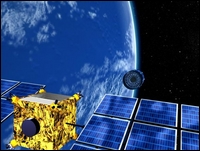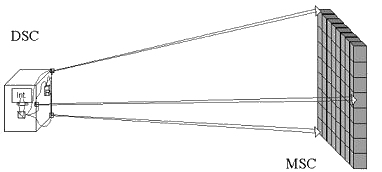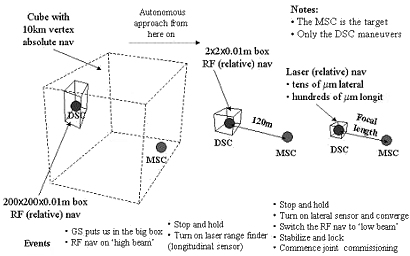XEUS Formation Flight
Formation Flying Requirements
XEUS requires a focal length that is much longer than any spacecraft flown to date could accommodate. Therefore the mission will consist of two freeflyers: a mirror spacecraft (MSC) and a detector spacecraft (DSC), separated such that the operational detector is at the focus of the mirror.
 |
|
Artist's impression of NXO |
The maintenance of the mirror focal point on the science instrument detector determines the accuracy of the spacecraft position control. The DSC along-axis position needs to be variable up to 150 mm, but during an observation its position should be maintained to within a few millimetres. Laterally, the DSC must maintain its location relative to the MSC with a tolerance of 1 mm. The focal point can wander laterally on timescales typically much longer than a millisecond as long as this location is accurately known. With two instruments on the DSC, the formation flying will have to align the focal point on the selected instrument's detector.
The MSC is required to locate the celestial target with an acquisition accuracy of ~10 arcseconds, driven mainly by the necessity to ensure that the variation with field angle is very small over the observation. Then from the formation flying aspects, the MSC remains in a passive role, and the DSC ensures that the focal plane spot is tracked with sufficient accuracy.
Launch & rendezvous scenario
Both spacecraft will be launched together and remain with the same local vacinity on the journey to the orbit around L2.
Normal ranging with Doppler measurements at one ground station should allow an accuracy of ~10km at L2. Aspects of the subsequent rendezvous approach are illustrated graphically in the figure below. At a distance of 10km, the RF system of DSC locates the MSC with an accuracy ~200 metres. Using cold gas the DSC nears the MSC, with the RF ranging accuracy increasing inversely with the approach distance, where an accuracy of a few centimetres is achieved longitudinally and 1° laterally. When the separation is reduced to ~ 120m. At this stage a laser range finder and interferometer are activated and the final approach to the focal distance operating point is made, with an ultimate accuracy of ~10’s µm lateral and 100’s µm longitudinal being predicted.
|
|
|
Concept of the rendezvous strategy. Coarse rendezvous begins (left) with the ground segment locating the two spacecraft within 10km of each other via Doppler ranging. Autonomous RF ranging between DSC and MSC allows 1 degree later accuracy and centimetre longitudinal accuracy, and allows navigation to less than 100m where the formation-flying subsystems can assume command. |
Metrology
The angular resolution goal of 2 arcseconds HEW demands already that the DSC returns attitude knowledge to 1 arcsecond or better, therefore the DSC as a baseline contains a high quality star tracker. The performance of this unit allows the DSC to be accurately locked to the celestial location, but any relative shift between spacecraft will be measured by the formation flying metrology system.
 |
|
Concept of the formation-flying metrology |
The system is based on developments for the Darwin project, but already demonstrated as a laboratory breadboard with sufficient accuracy to meet the XEUS requirements. First of all, an Absolute Distance Measuring (ADM) laser rangefinder is used to determine the along-axis distance between MSC and DSC. The lab demonstration already offers, at a range of 60m, a resolution of 50 microns. Next a dual wavelength interferometer is used to perform range-finding to 3 corner cubes on the DSC. Two Nd:YAG lasers operating at 3GHz and beat wavelength ~10cm are implemented and the differential frequency lock allows a 3 micron accuracy on lateral shifts given a +/- 2.5 mm unambiguity range from the previous rangefinder absolute measurement. The same optical head is used for both systems and requires modest resources of ~5W and 3kg.

